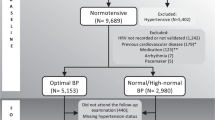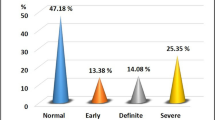Abstract
Background:
Little is known about the altered cardiac autonomic function (CAF) across different levels of body mass index (BMI), including underweight, normal weight, overweight and obesity. This study provides a thorough analysis to clarify the CAF change in subjects with underweight, overweight and obesity.
Methods:
According to the World Health Organization (WHO) Asia-Pacific BMI cutoffs, a total of 1437 participants were classified as underweight (n=74), normal weight (n=588), overweight (n=313), obesity I (n=390) and obesity II (n=72). CAF was determined by standard deviation of normal-to-normal (SDNN) intervals or RR intervals, power spectrum in low (LF) and high frequency (HF) (LF, 0.04–0.15 Hz; HF, 0.15–0.40 Hz), and LF/HF ratio at supine for 5 min, the ratio between the 30th and the 15th RR interval after standing from the supine position (30/15 ratio) and the average heart-rate change while taking six deep breaths in 1 min (HRDB).
Results:
There were significant differences in age, gender, socioeconomic status, blood pressure, HOMA insulin resistance index, fasting glucose, cholesterol, triglyceride and high-density lipoprotein (HDL)-C, and the prevalence of hypertension, ischemic/left bundle branch block (LBBB) electrocardiography (EKG) pattern, current smoking and alcohol use among subjects with underweight, normal weight, overweight, obesity I and II. Univariate analysis showed that SDNN, HRDB, HF power and the square root of the LF/HF ratio differed among these five groups. Multivariate analysis showed that obesity I and II were inverse correlates of HRDB and HF power. Overweight, obesity I and II were positively associated with the square root of the LF/HF ratio. No BMI status was related to SDNN, 30/15 ratio or LF power. Underweight was not the independent correlate of any CAF indices.
Conclusions:
The risk for altered CAF is significant in overweight and obese subjects, independent of cardiovascular risk factors. Underweight is not apparently associated with CAF change.
This is a preview of subscription content, access via your institution
Access options
Subscribe to this journal
Receive 12 print issues and online access
$259.00 per year
only $21.58 per issue
Buy this article
- Purchase on Springer Link
- Instant access to full article PDF
Prices may be subject to local taxes which are calculated during checkout

Similar content being viewed by others
References
WHO. Obesity: Preventing and Managing the Global Epidemic. WHO: Geneva, 2000. Report of a WHO Consultation. WHO Technical Report Series 894.
Shetty PS, James WPT . Body mass index: a measure of chronic energy deficiency in adults. FAO Food Nutr Pap 1994; 56: 1–57.
Flegal KM, Graubard BI, Williamson DF, Gail MH . Excess deaths associated with underweight, overweight, and obesity. JAMA 2005; 293: 1861–1867.
Calle EE, Thun MJ, Petrelli JM, Rodriguez C, Heath Jr CW . Body mass index and mortality in a prospective cohort of U.S. adults. N Engl J Med 1999; 341: 1097–1105.
Higashi Y, Sasaki S, Nakagawa K, Kimura M, Noma K, Sasaki S et al. Low body mass index is a risk factor for impaired endothelium-dependent vasodilation in humans: role of nitric oxide and oxidative stress. J Am Coll Cardiol 2003; 42: 256–263.
Boschmann M, Schroeder C, Christensen NJ, Tank J, Krupp G, Biaggioni I et al. Norepinephrine transporter function and autonomic control of metabolism. J Clin Endocrinol Metab 2002; 87: 5130–5137.
Dart AM, Du XJ, Kingwell BA . Gender, sex hormones and autonomic nervous control of the cardiovascular system. Cardiovasc Res 2002; 53: 678–687.
Task force of the European Society of Cardiology and the North American Society of Pacing and Electrophysiology. Heart rate variability standards of measurement, physiological interpretation, and clinical use. Circulation 1996; 93: 1043–1065.
Howorka K, Pumprla J, Schabmann A . Optimal parameters for short-term heart rate spectrogram for routine evaluation of diabetic cardiovascular autonomic neuropathy. J Auton Nerv Syst 1998; 69: 164–172.
Freeman R, Saul P, Roberts M, Berger RD, Broadbridge C, Cohen R . Spectral analysis of heart rate in diabetic autonomic neuropathy. Arch Neurol 1991; 48: 185–190.
Rossi M, Marti G, Ricordi L, Fornasari G, Finardi G, Fratino P et al. Cardiac autonomic dysfunction in obese subjects. Clin Sci 1989; 76: 567–572.
Zahorska-Markiewicz B, Kuagowska E, Kucio C, Klin M . Heart rate variability in obesity. Int J Obes Relat Metab Disord 1993; 17: 21–23.
Arrone LJ, Mackintosh R, Rosenbaum M, Leibel RL, Hirsch J . Cardiac autonomic nervous system activity in obese and never-obese young men. Obes Res 1997; 5: 354–359.
Freeman R, Weiss ST, Roberts M, Zbikowski SM, Sparrow D . The relationship between heart rate variability and measures of body habitus. Clin Auton Res 1995; 5: 261–266.
Valensi P, Paries J, Attali JR . French Group for Research and Study of Diabetic Neuropathy. Cardiac autonomic neuropathy in diabetic patients: influence of diabetes duration, obesity, and microangiopathic complications—The French multicenter study. Metabolism 2003; 52: 815–820.
Antelmi I, de Paula RS, Shinzato AR, Peres CA, Mansur AJ, Grupi CJ . Influence of age, gender, body mass index, and functional capacity on heart rate variability in a cohort of subjects without heart disease. Am J Cardiol 2004; 93: 381–385.
Emdin M, Gastaldelli A, Muscelli E, Macerata A, Natali A, Camastra S et al. Hyperinsulinemia and autonomic nervous system dysfunction in obesity: effects of weight loss. Circulation 2001; 103: 513–519.
Kupari M, Virolainen J, Koskinen P, Tikkanen MJ . Short-term heart rate variability and factors modifying the risk of coronary artery disease in a population sample. Am J Cardiol 1993; 72: 897–903.
Andersson B, Wikstrand J, Ljung T, Bjork S, Wennmalm A, Bjorntorp P . Urinary albumin excretion and heart rate variability in obese women. Int J Obes Relat Metab Disord 1998; 22: 399–405.
Gelber DA, Pfeifer M, Dawson B, Schumer M . Cardiovascular autonomic nervous system tests: determination of normative values and effect of confounding variables. J Auton Nerv Syst 1997; 62: 40–44.
Richter WO, Geiss HC, Aleksic S, Schwandt P . Cardiac autonomic nerve function and insulin sensitivity in obese subjects. Int J Obes Relat Metab Disord 1996; 20: 966–969.
Vaz M, Bharathi AV, Sucharita S, Nazareth D . Heart rate variability and baroreflex sensitivity are reduced in chronically undernourished, but otherwise healthy, human subjects. Clin Sci 2003; 104: 295–302.
Lu FH, Yang YC, Wu JS, Wu CH, Chang CJ . A population-based study of the prevalence and associated factors of diabetes mellitus in southern Taiwan. Diabet Med 1998; 15: 564–572.
Hollingshead AB . Hollingshead two factor index of social position. In: Miller DC (ed). Handbook of Research Design and Social Measurement, 5th edn. Sage Publications: Newbury Park California, 1991. pp 351–359.
Paffenbarger Jr RS, Blair SN, Lee IM, Hyde RT . Measurement of physical activity to assess health effects in free-living populations. Med Sci Sports Exerc 1993; 25: 60–70.
Weisell RC . Body mass index as an indicator of obesity. Asia Pac J Clin Nutr 2002; 11 (Suppl): S681–S684.
Matthews DR, Hosker JP, Rudenski AS, Naylor BA, Treacher DF, Turner RC . Homeostasis model assessment: insulin resistance and b-cell function from fasting plasma glucose and insulin concentrations in man. Diabetologia 1985; 28: 412–419.
Blackburn H, Keys A . The electrocardiogram in population studies: a classification system. Circulation 1960; 21: 1160–1175.
Chobanian AV, Bakris GL, Black HR, Cushman WC, Green LA, Izzo Jr JL et al. The seventh report of the Joint National Committee on Prevention, Detection, Evaluation, and Treatment of High Blood Pressure: the JNC 7 report. JAMA 2003; 289: 2560–2572.
Arone LJ, Mackintosh R, Rosenbaum M, Leibel RL, Hirsch J . Autonomic nervous system activity in weight gain and weight loss. Am J Physiol 1995; 269: R222–R225.
Colhoun HM, Francis DP, Rubens MB, Underwood SR, Fuller JH . The association of heart-rate variability with cardiovascular risk factors and coronary artery calcification: a study in type 1 diabetic patients and the general population. Diabetes Care 2001; 24: 1108–1114.
Bergholm R, Westerbacka J, Vehkavaara S, Seppala-Lindroos A, Goto T, Yki-Jarvinen H . Insulin sensitivity regulates autonomic control of heart rate variation independent of body weight in normal subjects. J Clin Endocrinol Metab 2001; 86: 1403–1409.
Spraul M, Ravussin E, Fontvieille AM, Rising R, Larson DE, Anderson EA . Reduced sympathetic nervous activity. A potential mechanism predisposing to body weight gain. J Clin Invest 1993; 92: 1730–1735.
Straub RH, Thum M, Hollerbach C, Palitzsch KD, Scholmerich J . Impact of obesity on neuropathic late complications in NIDDM. Diabetes Care 1994; 17: 1290–1294.
Acknowledgements
This study was supported by grants from the National Science Council, Taiwan, Republic of China (NSC 88-2314-B-006-096, NSC 89-2314-B-006-043 and NSC 92-2314-B-006-117).
Author information
Authors and Affiliations
Corresponding author
Rights and permissions
About this article
Cite this article
Wu, JS., Lu, F., Yang, YC. et al. Epidemiological evidence of altered cardiac autonomic function in overweight but not underweight subjects. Int J Obes 32, 788–794 (2008). https://doi.org/10.1038/sj.ijo.0803791
Received:
Revised:
Accepted:
Published:
Issue Date:
DOI: https://doi.org/10.1038/sj.ijo.0803791
Keywords
This article is cited by
-
Relationship between HRV measurements and demographic and clinical variables in a population of patients with atrial fibrillation
Heart and Vessels (2016)
-
Prediabetic Neuropathy: Does It Exist?
Current Diabetes Reports (2012)
-
Neuropathy in prediabetes: does the clock start ticking early?
Nature Reviews Endocrinology (2011)
-
Central Fat Influences Cardiac Autonomic Function in Obese and Overweight Girls
Pediatric Cardiology (2011)



